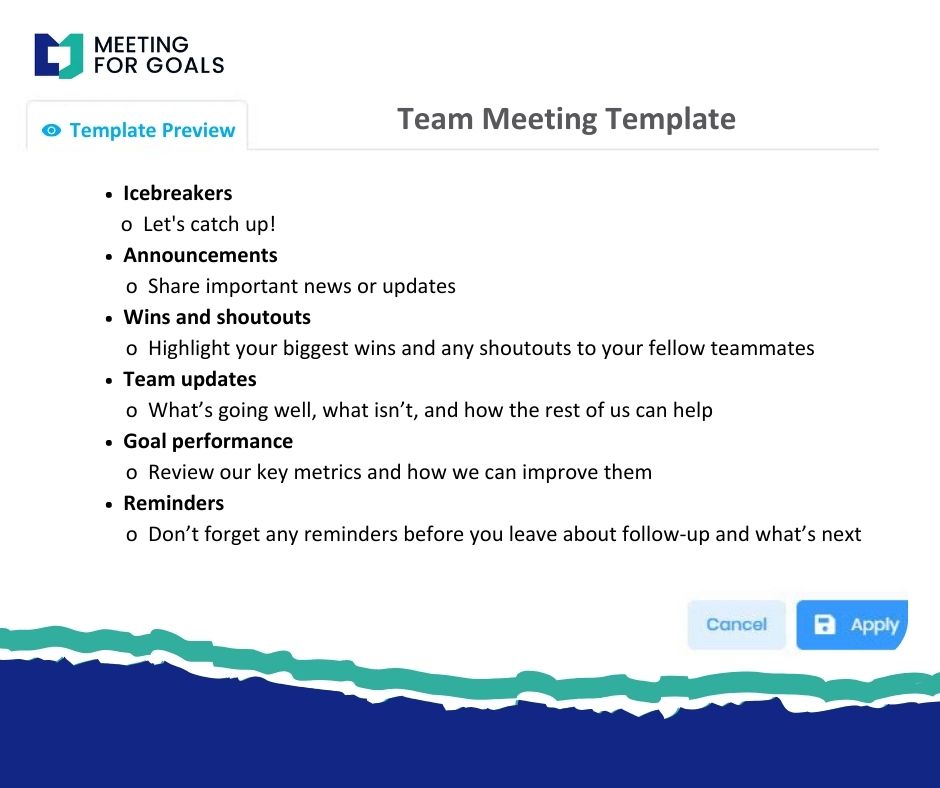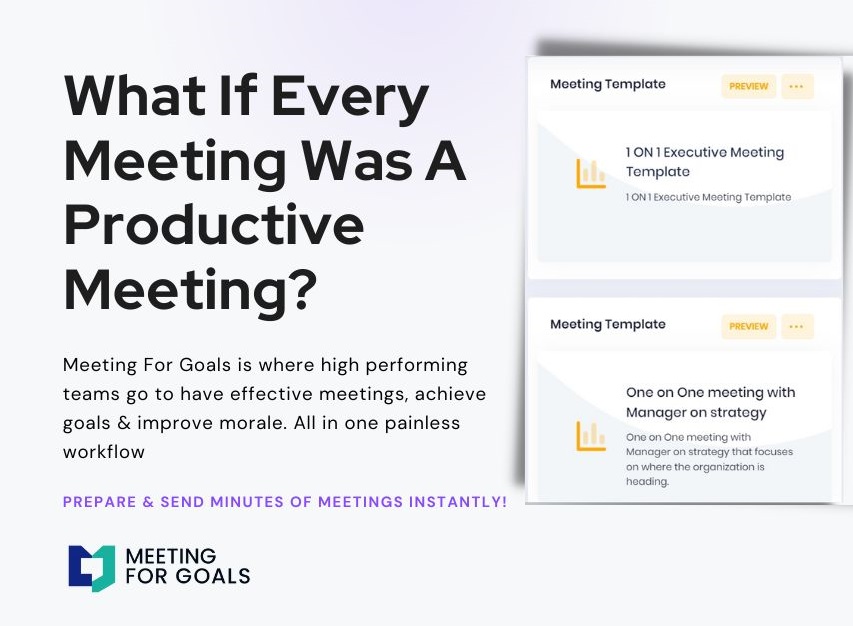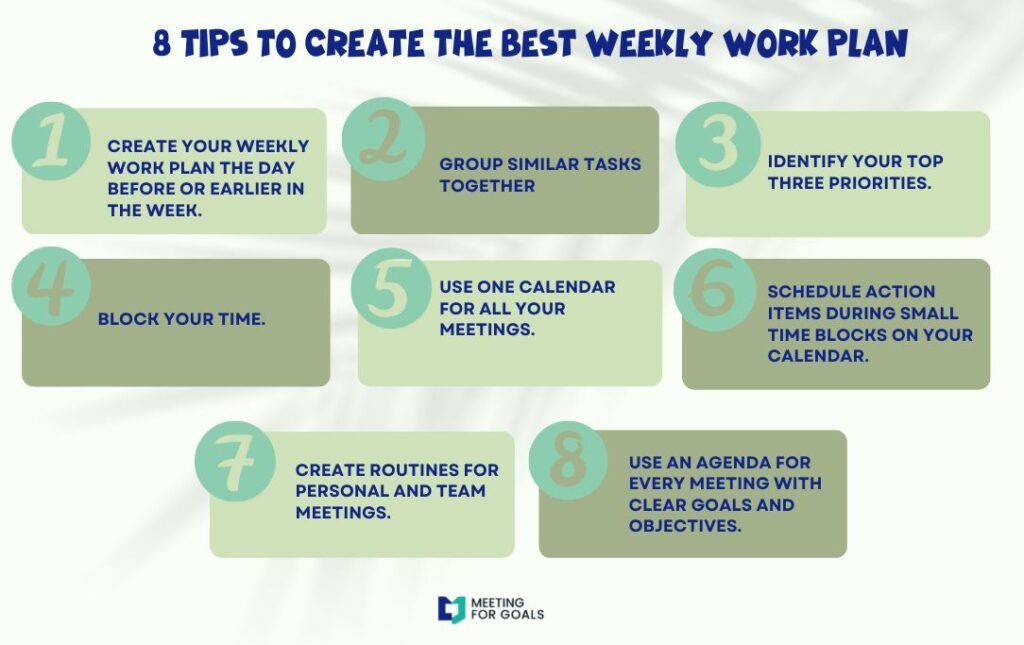Effective Meetings: The Key to Achieving Team Goals
Excerpt:
In today’s fast-paced business environment, time is money—and nowhere is that more apparent than in the boardroom. For companies with 40 to 70 employees, particularly those led by high-level executives, the difference between a productive meeting and a wasted hour can mean the difference between hitting quarterly targets or missing them. In this blog, we’ll explore how effective meetings are critical to achieving team goals. We will also discuss how Meeting For Goals—the ultimate meeting management software—can help your organization transform its meeting culture to boost productivity, alignment, and morale.
I. Introduction
Meetings are the heartbeat of any organization. They’re where ideas take shape, decisions are made, and strategies are aligned. However, for many mid-sized companies—especially those with 40 to 70 employees—meetings often feel like a drain on time and energy.
Inefficient meetings can lead to frustration, confusion, and lost momentum. They waste valuable time, lower team morale, and create misalignment across departments.
That’s where effective meetings come in. These meetings have a clear purpose, a defined structure, and a focus on outcomes. Everyone knows why they’re there, what they’re contributing, and what happens next.
Enter Meeting For Goals—a powerful meeting management software designed for high-performing teams. It helps you run shorter, more impactful meetings by aligning discussions with your company’s goals. With features like:
- Task tracking
- Role assignments
- Automated follow-ups
It ensures every meeting drives results. In this blog, we’ll break down how to run meetings that actually move your team forward. If you’re a Director, VP, or C-suite leader, you’ll walk away with practical strategies—and a tool that can help you execute them. Ready to make your meetings count? Start by exploring our free meeting templates to get inspired.
2 Minute Video
Watch a 2 minute demo of our meeting management software in action
II. The Importance of Effective Meetings
Let’s face it—most people dread meetings. And for good reason. A Harvard Business Review study found that executives spend an average of 23 hours a week in meetings, with 71% considering them unproductive.
For mid-sized companies, this inefficiency is even more costly. You’ve got leaner teams, tighter resources, and less room for error.
Ineffective meetings can lead to:
- Misalignment between teams
- Missed deadlines
- Redundant work
- Low engagement
- Poor decision-making
But when meetings are done right, they become a strategic advantage.
Effective meetings foster better communication, faster decisions, and stronger alignment with company goals. Your team becomes more agile and motivated because they know their time is being used wisely.
Let’s look at a real-world scenario. A VP of Operations at a 60-person tech company notices that weekly meetings are dragging on, lacking focus, and producing no clear outcomes. The team is disengaged.
Now imagine the same team using Meeting For Goals. Everyone gets a clear agenda ahead of time. Tasks are assigned during the meeting. A summary with action items is sent out automatically. Suddenly, meetings are shorter, more focused, and actually help the team move forward.
Effective meetings aren’t just about saving time—they’re about increasing the quality of collaboration. For leaders, investing in better meetings means investing in your company’s future.
Want to see how your meetings stack up? Check out this article from Forbes on why bad meetings are killing productivity—and how to fix them.
Adding an Agenda
How to add an agenda instantly on Meeting For Goals
III. Tips for Planning Productive Meetings
Great meetings don’t happen by accident. They’re carefully planned and purpose-driven.
Here’s how to set your meetings up for success:
- Define Clear Objectives
Start with the “why.” What’s the purpose of the meeting? Are you making a decision, solving a problem, or sharing updates?
Be specific. Instead of “Discuss Q3 marketing,” say “Finalize Q3 marketing initiatives aligned with lead-gen targets.”
With Meeting For Goals, you can link each meeting to specific OKRs, so every conversation supports your bigger goals.
- Invite the Right People
Too many people in the room? You’ll lose focus. Too few? You’ll miss critical insights.
Only invite those who are essential to the meeting’s objective. For example, if you’re discussing a product feature, include product managers, engineers, and customer success reps—but not the entire sales team.
Meeting For Goals helps you tag stakeholders and decision-makers so you always have the right mix in the room.
- Prepare and Share an Agenda
An agenda is your meeting’s roadmap. Without one, it’s easy to veer off course.
Send the agenda at least 24 hours in advance. Include time estimates for each topic and assign presenters if needed.
With Meeting For Goals, agenda creation and distribution are automated—saving you time and keeping everyone aligned.
- Set a Time Limit
Meetings should be as short as possible, but as long as necessary. Use timeboxing to keep things moving.
For example, allocate 10 minutes for updates, 15 minutes for discussion, and 5 minutes for decisions.
Meeting For Goals includes built-in timers to help you stay on track.
- Choose the Right Format
Not every meeting needs to be a Zoom call. Some updates can be shared asynchronously or handled in a quick huddle.
Choose the format that best fits your objective—and your team’s working style.
Want help planning your next meeting? Try one of our ready-to-use meeting templates to get started quickly.
IV. Best Practices During Meetings
Once the meeting starts, it’s all about execution. Here’s how to keep things focused and productive:
- Encourage Active Participation
A meeting isn’t a lecture. Everyone should have a voice.
Use a round-robin format to give each participant a chance to speak. Ask open-ended questions. Invite input from quieter team members.
Meeting For Goals makes it easy to assign speaking roles and time slots, so no one dominates the conversation.
- Assign Roles
Every meeting should have a:
- Facilitator: Guides the discussion
- Timekeeper: Keeps things moving
- Note-taker: Captures key points and action items
These roles create structure and accountability. With Meeting For Goals, you can assign and track these roles before the meeting even begins.
- Stick to the Agenda
Tangents happen. But when they do, use a “parking lot” to capture off-topic ideas for later discussion.
Staying on agenda keeps your meeting efficient and focused. Meeting For Goals provides real-time agenda tracking and visual timers to help you stay on course.
- Make Real-Time Decisions
Don’t just talk—decide. Use meetings to make decisions and assign tasks on the spot.
This speeds up execution and eliminates the need for follow-up meetings. The software’s decision-tracking feature logs who made what decision and why—so there’s no confusion later.
- Document Key Takeaways
Don’t rely on memory. Capture key insights, decisions, and next steps in real time.
Meeting For Goals automates note-taking and lets you assign tasks with deadlines and owners—right from the meeting screen.
Want to see what this looks like in action? Book a demo today and discover how Meeting For Goals can transform your meetings.
V. Post-Meeting Follow-Up
The real value of a meeting shows up after it ends. Here’s how to make sure your team follows through:
- Summarize Meeting Outcomes
Send a summary immediately after the meeting. Include key decisions, action items, and next steps. This keeps everyone aligned and accountable.
Meeting For Goals automatically generates and sends out meeting summaries—so nothing slips through the cracks.
- Track Action Items and Deadlines
Every task should have an owner and a due date. Otherwise, things fall through the cracks.
Use a task management system to track progress and send reminders.
Meeting For Goals integrates task tracking into your meeting workflow. You can assign tasks during the meeting and monitor progress afterward.
- Measure Meeting Effectiveness
Ask your team: Was this meeting valuable? Did we meet our objectives? Use feedback to improve future meetings.
Meeting For Goals includes built-in feedback tools so you can gather input and continuously improve.
- Follow-Up Strategically
Don’t schedule another meeting just because it’s on the calendar. Only meet again if there’s a clear reason and measurable progress since the last session.
Use Meeting For Goals’ analytics dashboard to see which meetings are driving results—and which ones need rethinking.
Want more insights? Check out this article from McKinsey on how high-performing teams use meetings to drive execution.
VI. Conclusion
In today’s business world, time is your most valuable asset. For companies with 40 to 70 employees, effective meetings aren’t optional—they’re essential.
When meetings are planned with purpose, run with precision, and followed up with accountability, they become a powerful tool for growth and alignment.
Meeting For Goals is built for leaders who want to make every meeting count. Whether you’re aligning on strategy, solving problems, or tracking progress, our software helps you do it faster and more effectively.
From goal alignment and task tracking to automated follow-ups and real-time analytics, Meeting For Goals turns meetings into a competitive advantage.
Ready to revolutionize how your team meets and executes? Sign up today and experience the difference: https://app.meetingforgoals.com/TenantRegistration/Register
And don’t forget to explore our collection of free meeting templates to jumpstart your journey toward more effective meetings.
Make every meeting count. Visit https://meetingforgoals.com to learn more.



